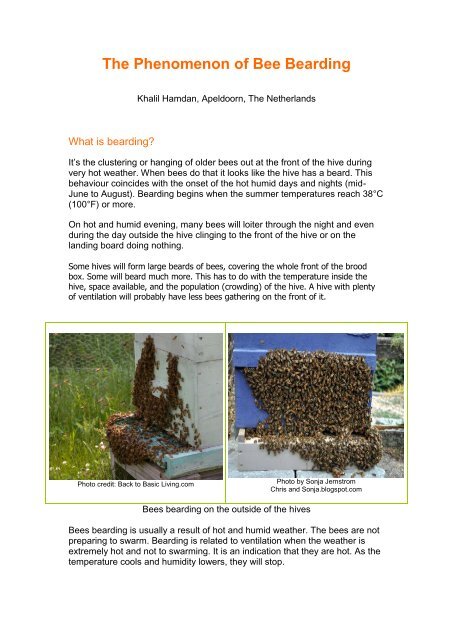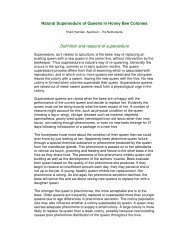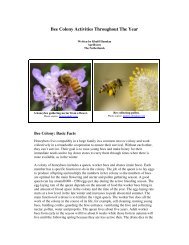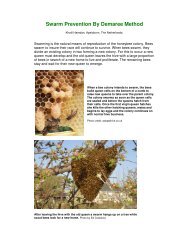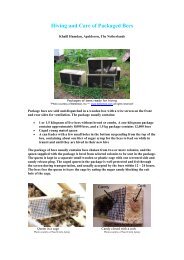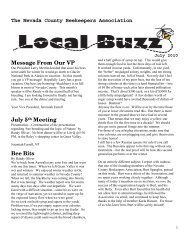The Phenomenon of Bee Bearding - Country Rubes
The Phenomenon of Bee Bearding - Country Rubes
The Phenomenon of Bee Bearding - Country Rubes
Create successful ePaper yourself
Turn your PDF publications into a flip-book with our unique Google optimized e-Paper software.
<strong>The</strong> <strong>Phenomenon</strong> <strong>of</strong> <strong>Bee</strong> <strong>Bearding</strong><br />
What is bearding?<br />
Khalil Hamdan, Apeldoorn, <strong>The</strong> Netherlands<br />
It’s the clustering or hanging <strong>of</strong> older bees out at the front <strong>of</strong> the hive during<br />
very hot weather. When bees do that it looks like the hive has a beard. This<br />
behaviour coincides with the onset <strong>of</strong> the hot humid days and nights (mid-<br />
June to August). <strong>Bearding</strong> begins when the summer temperatures reach 38°C<br />
(100°F) or more.<br />
On hot and humid evening, many bees will loiter through the night and even<br />
during the day outside the hive clinging to the front <strong>of</strong> the hive or on the<br />
landing board doing nothing.<br />
Some hives will form large beards <strong>of</strong> bees, covering the whole front <strong>of</strong> the brood<br />
box. Some will beard much more. This has to do with the temperature inside the<br />
hive, space available, and the population (crowding) <strong>of</strong> the hive. A hive with plenty<br />
<strong>of</strong> ventilation will probably have less bees gathering on the front <strong>of</strong> it.<br />
Photo credit: Back to Basic Living.com<br />
<strong>Bee</strong>s bearding on the outside <strong>of</strong> the hives<br />
Photo by Sonja Jernstrom<br />
Chris and Sonja.blogspot.com<br />
<strong>Bee</strong>s bearding is usually a result <strong>of</strong> hot and humid weather. <strong>The</strong> bees are not<br />
preparing to swarm. <strong>Bearding</strong> is related to ventilation when the weather is<br />
extremely hot and not to swarming. It is an indication that they are hot. As the<br />
temperature cools and humidity lowers, they will stop.
Why do bees beard?<br />
<strong>The</strong> average temperature in the beehive is between 32-35°C (90-95°F).<br />
Honeybees have the ability to regulate the temperature <strong>of</strong> their nest<br />
throughout the year. If it is cold, bees raise the temperature within the hive by<br />
huddling together to keep warm and vibrating their wing muscles to generate<br />
heat. If it is hot, they lower it by fanning their wings to circulate air through the<br />
hive. If it is really hot, they collect water for evaporative cooling. Droplets <strong>of</strong><br />
water are placed inside the hive, then the bees stand in a line facing the hive<br />
entrance fanning their wings creating air currents that evaporate the water,<br />
thus cooling the hive. Whenever fanners are at the entrance, there are many<br />
inside the hive doing similar fanning to control the hive temperature.<br />
On a hot day bees gathered at the hive entrance are fanning with their<br />
wings to ventilate and cool the hive.<br />
Photo credit: Lloyd Ziegler<br />
In extremely hot weather, when the hive’s internal temperatures can rise to<br />
excessive levels and the hive population is so great, bees make their way out<br />
and cluster outside the hive in a huge numbers, here they can try to escape<br />
from the heat and remain cool. Honeybees do this mostly to keep the inside <strong>of</strong><br />
the hive from overheating and killing the brood (immature bees), and to help<br />
regulate the brood nest temperature. Brood and too many busy bees in the<br />
hive increase heat output. It is a simple way to regulate the internal hive<br />
temperature.<br />
Often bees beard because the temperature outside is high, lack <strong>of</strong> ventilation<br />
and overcrowding. During lack <strong>of</strong> honey flow in summer the field bees don’t<br />
have any work to do, therefore if the hive is hot, they will crowd together out<br />
on the front <strong>of</strong> the hive out <strong>of</strong> the way <strong>of</strong> the busy house bees.
<strong>Bearding</strong> and swarming<br />
<strong>Bearding</strong> and swarming tend to happen at different time. <strong>Bearding</strong> happens in<br />
mid to late summer. Swarming mostly occurs in mid spring (March-May) in<br />
warm regions and in early summer (May & June) in most cold climates.<br />
Swarms usually emerge from the colonies particularly between 10am and<br />
2pm on warm, sunny days.<br />
<strong>Bearding</strong> happens most <strong>of</strong>ten late in the day and into early evening, where<br />
some bees evacuate the hive and hang in a cluster resembling a swarm<br />
outside the entrance <strong>of</strong> the hive. A hive that is bearding will have its bees<br />
coming and going in and out <strong>of</strong> the entrance, and the bees are <strong>of</strong>ten fanning<br />
to keep the hive cool. By the next morning all or most <strong>of</strong> the bees are back<br />
inside the hive because the outside air temperature has dropped and it is<br />
“business” is as usual. This is not likely to be seen in the spring when<br />
swarming is at its peak. If the clustering is taking place during spring weather,<br />
it is most likely the hive will swarm.<br />
A hive that is at the point <strong>of</strong> swarming looks different. <strong>The</strong> bees are clinging to<br />
the outside <strong>of</strong> the hive coating the front in a scattered fashion facing<br />
downwards, or hanging from the bottom in a conical fashion. <strong>The</strong> hive emits a<br />
roar sound signaling swarm departure. Thousands <strong>of</strong> bees emerge and hover<br />
around the hive. Once the queen joins them they fly <strong>of</strong>f at once in a buzzing<br />
cloud. <strong>The</strong> process <strong>of</strong> leaving the original hive may last 10 -15 minutes.<br />
A swarm preparing to cast <strong>of</strong>f. Photo by Ira Seskin<br />
What should the beekeeper do?<br />
Once this behaviour is observed, the beekeeper should intervene and make<br />
sure the bees have good ventilation and enough room. More ventilation is<br />
required in the hive during hot weather. Less-ventilated hives get hot.
Screened bottom boards (sbb’s) help with the ventilation in the hive in the<br />
summer and reduce bearding. <strong>The</strong> sbb is put on the hive stand instead <strong>of</strong> the<br />
regular bottom board to give more ventilation in springtime and summer and<br />
taken out when weather turns cooler in autumn. Screened bottom boards can<br />
be made easily from plans on the Internet or purchased from bee equipment<br />
suppliers. Another technique to aid the ventilation and relieve the heat is<br />
propping open the outer cover about 2,5 cm (1 inch) with a piece <strong>of</strong> wood.<br />
<strong>Country</strong> <strong>Rubes</strong> Screened Bottom Board<br />
<strong>The</strong> beekeeper may need to add additional boxes (supers) to give the bees<br />
more space to spread out and relieve congestion.<br />
Unshaded hives would probably overheat in full sun in warmer summer days<br />
and bees would cluster at the entrance. It will help to put them in a shady<br />
location, for example, under a tree or build some sort <strong>of</strong> shade to screen them<br />
from the intense sun during the summer months. However deep shade is<br />
unnecessary. <strong>The</strong> ideal location should be where hives are shaded from the<br />
midday sun. This allows the bees to concentrate more <strong>of</strong> their efforts on raise<br />
brood, collect pollen and nectar instead <strong>of</strong> having to bring in water to cool the<br />
hive. A hive with afternoon shade will <strong>of</strong>ten produce more than hives sitting in<br />
the hot afternoon sun.<br />
Tips<br />
Hot weather is hard on the bees, especially if hives are not very well shaded<br />
from the sun. Here are some tips to help them to get some ventilation inside<br />
the hive and to reduce heat stress.<br />
� Nothing beats the screened bottom board for ventilation.<br />
� Increase the entrance space. Larger entrances are good for hot<br />
weather.<br />
� Place shade boards to shade the hives, especially if the sun is beating<br />
on them. A hive <strong>of</strong> bees that is exposed to the direct rays <strong>of</strong> the sun<br />
has a much more difficulty in keeping the interior <strong>of</strong> the hive cool than<br />
when the hive is in the shade.<br />
� If you have10 frames consider going to 9 to allow more space for<br />
ventilation.
� Provide an upper hive entrance to improve ventilation in warm humid<br />
conditions during the summer. An upper entrance can be made <strong>of</strong> a<br />
wooden frame with a landing board similar to a screened bottom board<br />
but without a screen. While the bees will use the lower entrance<br />
mainly, they will also fly from the other vent.<br />
An upper entrance placed between the brood chamber and the super.<br />
(Photo credit: Barnboy.com)<br />
� Place a ventilation box with screened openings on top <strong>of</strong> the inner cover, then<br />
place the outer cover on top <strong>of</strong> the ventilation box. This way allows for good<br />
airflow through the hive. Ventilation boxes can be made out <strong>of</strong> unused honey<br />
supers, drill holes in the sides on a slant so rain would not enter and screen<br />
them on the inside so no robbing would occur.<br />
Screened ventilation boxes. Photos by Bill Mondjack<br />
� Painting hive bodies with white paint or some other light colour helps to<br />
reduce overheating. White reflects the sun’s heat in the summer<br />
months and keeps the hive cooler, especially in hot region. Dark colour<br />
paint would absorb more heat.<br />
� Use an inner cover with either a wider or two openings.
� Provide a source <strong>of</strong> water for the bees in a partially shaded position<br />
near the apiary (within half mile or less). On a hot day a strong colony<br />
will use over a litre <strong>of</strong> water to cool the hive and to prevent overheating.<br />
A strong beehive will use over a litre <strong>of</strong> water on a hot day. <strong>The</strong><br />
Boardman or entrance feeder is a good way to provide water in hot<br />
summertime.<br />
� Sliding a super back about 2,5 cm (one inch) to improve airflow is not a<br />
recommended approach. This may encourage robbing and allow rain<br />
to get inside the hive.<br />
� Remove a few frames <strong>of</strong> honey or harvest supers when sealed, and<br />
add new boxes <strong>of</strong> frames to provide space and ventilation.


